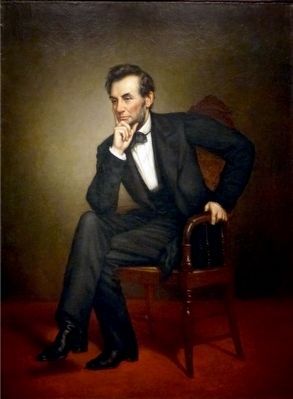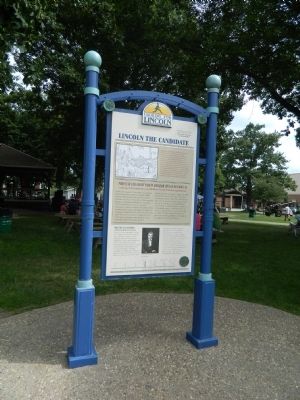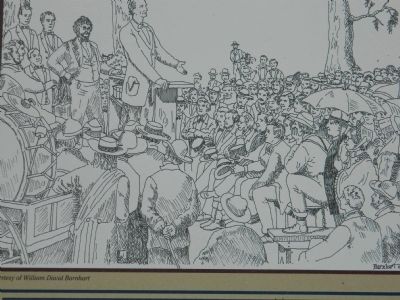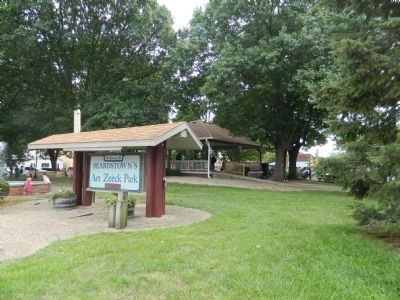Lincoln the Candidate
Looking for Lincoln
People in Cass County knew Abraham Lincoln not only as a lawyer but also as a candidate for the Illinois legislature and U.S. Congress. Those earlier campaigns allowed Lincoln to hone his political skills for the 1858 senatorial content that pitted Lincoln and the new Republican Party against Democrat incumbent Stephen A. Douglas. "Mr. Lincoln leaves tomorrow evening for Beardstown, where he will throw some of his hot shot into the Douglas camp, and charge home upon the doughface. It will be the work of Lincoln to show the people the truth and to paint the dodger as he is." a Chicago newspaper correspondent wrote from Springfield. Lincoln arrived in Beardstown the morning of August 12, 1858 aboard the steamer Sam Gaty. A Chicago newspaper reported that 300 to 400 people met Lincoln upon his arrival and escorted him as he rode by to the National Hotel. At 2:00 P.M., Lincoln walked to a platform in the public square, where he delivered a two-hour speech before a crowd estimated at 2,500 to 3,000 people. His supporters gave him a rousing sendoff as he boarded a steamboat for the trip to Havana.
Beardstown artist William Barnhart has depicted Lincoln addressing the enthusiastic crowd in Beardstown, August 12, 1858. The audience for this speech, Lincoln's first of the regular senatorial campaign, included citizens from Morgan and Schuyler counties as well as from Beardstown and the rest of Cass County. There were two bands, two military companies, and a mounted escort to make up for the lack of a cannon, sabotaged by the Democrats. Both Lincoln and Douglas spoke to crowds larger than previously seen in any campaign. In addition, the press coverage was nationwide, giving Lincoln, a relatively unknown politician, the reputation which would enable his successful presidential bit two years later.
While the 1858 Senatorial contest may be Abraham Lincoln's best known political campaign, his bid for Congress in 1846 may rank as his most bizarre because of one incident. Lincoln's Democratic opponent was the famed Methodist circuit rider, Peter Cartwright. Fearing the popular Lincoln would coast to victory, Cartwright stirred the pot toward the end of the campaign by claiming that Lincoln openly scoffed Christianity. Just days before the election, Lincoln issued a handbill refuting Cartwright's accusation. In it, he explained: "That I am not a member of any Christian Church, is true; but I have never denied the truth of the Scriptures; and I have never spoken with intentional disrespect of religion in general, or of any denomination of Christians in particular." Though Cartwright's accusations had no obvious negative impact on the election-Lincoln won by an unprecedented
margin-questions about his religious views continued throughout his live.Erected by State of Illinois Historic Preservation Agency & Looking for Lincoln Heritage Coalition.
Topics and series. This historical marker is listed in this topic list: Government & Politics. In addition, it is included in the Former U.S. Presidents: #16 Abraham Lincoln, and the Looking for Lincoln series lists. A significant historical year for this entry is 1858.
Location. 40° 1.021′ N, 90° 26.08′ W. Marker is in Beardstown, Illinois, in Cass County. Marker is on West 2nd Street. Between Washington and State Streets in Art Zeeck Park. Touch for map. Marker is in this post office area: Beardstown IL 62618, United States of America. Touch for directions.
Other nearby markers. At least 8 other markers are within walking distance of this marker. Site of Abraham Lincoln's Speech (within shouting distance of this marker); Beardstown Grand Opera House (within shouting distance of this marker); Stephen A. Douglas Speech Site (within shouting distance of this marker); Lincoln the Lawyer (about 300 feet away, measured in a direct line); In Memory of Abraham Lincoln (about 300 feet away); Lincoln in Beardstown (about 300 feet away); Lincoln Photograph (about 300 feet away); Traveling to Beardstown (about 600 feet away). Touch for a list and map of all markers in Beardstown.

“Today Abraham Lincoln is universally regarded as one of our greatest presidents. But from the start of his administration, Lincoln, guiding the nation in a time of civil war, was beset with criticism from all sides. Some charged him with moral cowardice for initially insisting that an end to slavery was not one of his wartime goals; others accused him of overstepping his constitutional powers; still others blamed him for military reverses in the field. But as Union forces moved toward victory, Lincoln's eloquent articulation of the nation's ideals and his eventual call for an end to slavery gradually invested him with grandeur. following his assassination in 1865, that grandeur beca.me virtually unassailable.
The original version of this portrait was a template for artist George P. A. Healy's large painting The Peacemakers, depicting Lincoln in consultation with three of his main military advisers at the end of the Civil War. But Healy recognized that this made a fine portrait in its own right and eventually made three replicas, including this one.” — National Portrait Gallery
Credits. This page was last revised on October 9, 2019. It was originally submitted on July 26, 2012, by Bill Pfingsten of Bel Air, Maryland. This page has been viewed 571 times since then and 8 times this year. Photos: 1, 2. submitted on July 26, 2012, by Bill Pfingsten of Bel Air, Maryland. 3. submitted on October 29, 2015, by Allen C. Browne of Silver Spring, Maryland. 4. submitted on July 26, 2012, by Bill Pfingsten of Bel Air, Maryland.


